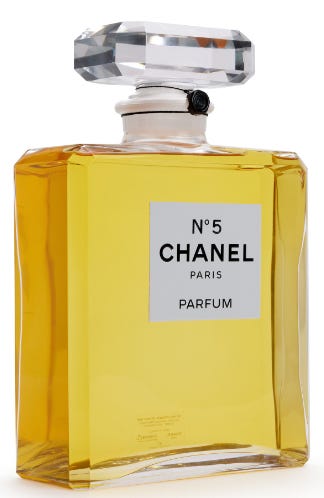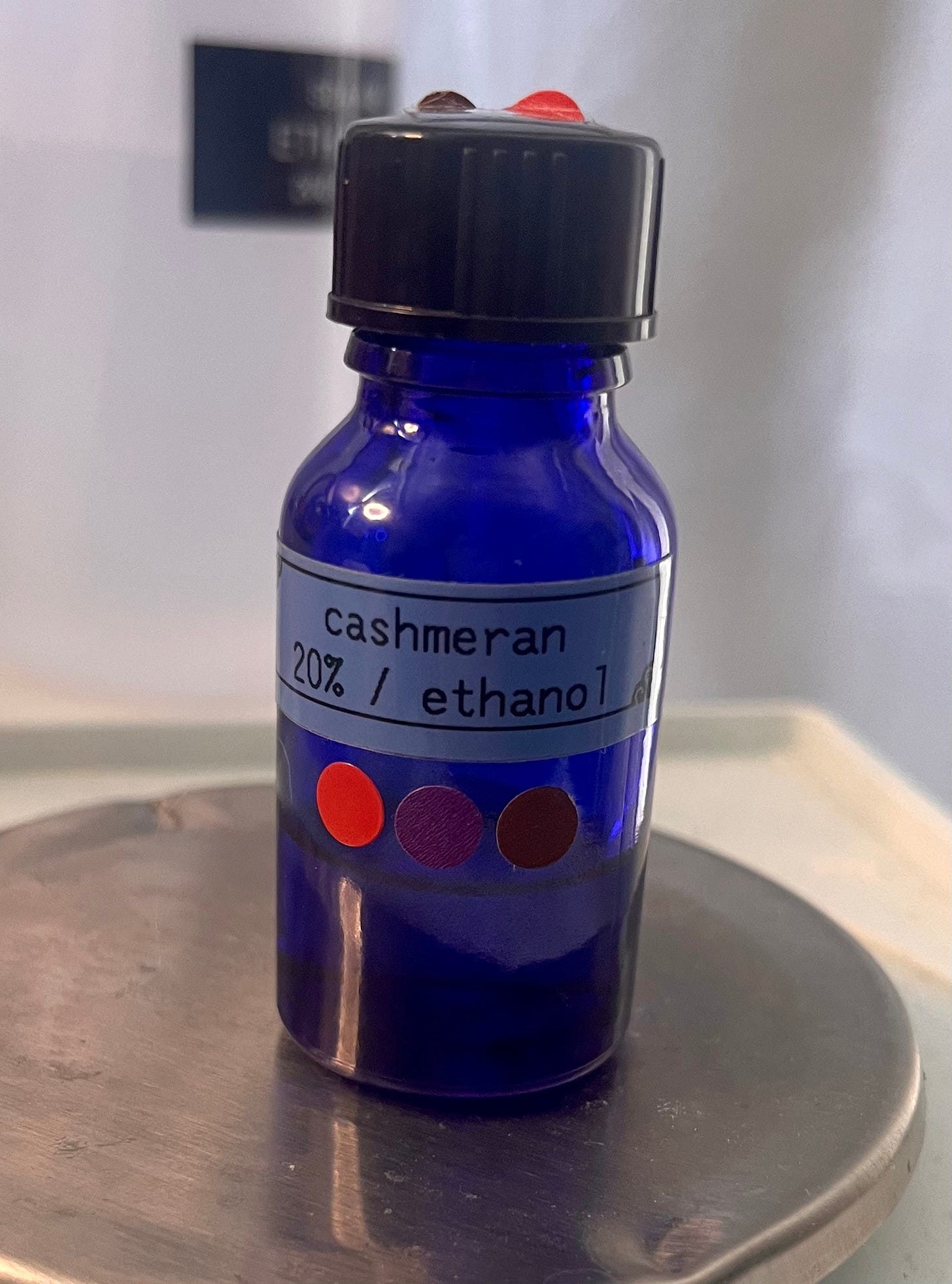This is the first in what I believe will be a series of posts spotlighting individual aromachemicals — we’ll see.
Today’s feature is Cashmeran, aka musk indanone, aka 1,2,3,5,6,7-Hexahydro-1,1,2,3,3-pentamethyl-4H-inden-4-one.
This is one of very few ACs to be something of a household name, or at least as close as aromachemicals get to household status! My rough test for this is whether Fragrantica has a “note” dedicated to the molecule, and this is extremely true for Cashmeran. Two hundred perfumes feature a Cashmeran note, and this is surely a minuscule subset of all perfumes that actually contain it.
Cashmeran is sometimes cloaked in the guise of fantastical stuff like ‘cashmere wood’1 or ‘blonde wood’ when listed in fragrance notes. That’s absurd, but I also don’t know how better to describe it. It is a musky-peppery-woodsy scent that defies clear categorization, and reminds me just a bit of stuffing your nose in a cashmere sweater. It’s gorgeous, and it’s mind boggling that a single molecule could be pulling so much nuance and complexity.
Cashmeran was first developed in the 1970s by our friends at IFF: a marvel of scent science. But I think of it as a very modern note, perhaps because it’s only recently become a star player, a featured note, not part of the scenery. We can see that the perfumes featuring a Cashmeran note on Fragrantica are mostly from the mid-aughts and beyond, with that note picking up steam in recent years, though this might also be a function of the continually increasing willingness by all parties to admit that perfumes are made of weird chemicals2.
Frederick Malle’s Dans Tes Bras, which purportedly contains a shocking 25% dose3 of Cashmeran, was released in 2008. To put this into perspective, the first and third quartiles for relative Cashmeran dose among the demonstration formulas listed on TGSC are 0.15% and 0.97%! Cashmeran isn’t merely featured in DTB, it is the hulking prima donna. Many Cashmeran bombs have followed since, an unending, beefy procession.
AC O.D.s: a tangent
The idea of “overdosing” a molecule, using it in proportions that are orders of magnitude higher than average, is a common rabbit from the perfumer's hat. Legend tells us that Chanel No. 5, with its fizzy, uncanny burst of aliphatic aldehydes in the top note, came about when an assistant to Chanel’s perfumer Ernest Beaux mistakenly used a full-strength aldehyde rather than a 10% dilution as called for in the sample formulation. I’ve no idea how true this is, but it’s certainly the case that many successful fragrances owe their success to the brash extremity of a typically subdued ingredient. Baccarat Rouge 540 (Maison Francis Kurkdjian, 2015) contains a shocking amount of ethyl maltol balanced against an equally unusual dose of Evernyl. Those two are typically used as fractions of a percent of the fragrance compound, but are present in 10-40x the usual proportion in BR5404!!
Oudunnit
Another reason for Cashmeran’s recent popularity is that, along with another favorite stinker of mine called Kephalis, it can be used to create a simulated, all-synthetic, and terribly affordable accord of oud, that wildly expensive, rare, divine product of of agarwood resin. Almost any commercial perfume you buy today that has oud in the name or touts an oud note is probably rocking Cashie ‘n Kephie under the hood. Having smelled many examples of real oud as well as many simulacra, I’d say the Cashmeran-Kephalis combo holds a pale mirror up to the very long dry-down effect of real oud. But it’s a lovely accord, very performant in a blend, and doesn’t require extracting resources from various ecologies of the global south like real oud does.
I’ll write a lot more about oud sometime if you’re not careful.
Note that the West began to go crazy for “oud” notes in perfume about a decade ago due to geopolitical conditions that I wish I could write about but I’m already pretty far out over my skis here.
Smell it in
Molecule 05 (Escentric Molecules, 2020, Geza Schoen) is almost entirely Cashmeran. You can easily find it in most Sephoras, department stores, airport duty free shops and so on.
While you’re there, you can compare with Escentric 05 (Escentric Molecules, 2020, Geza Schoen) which shows off Cashmeran in a more traditional perfume composition, set off against notes of bergamot, herbs, and white florals.
After smelling Molecule 05 and Escentric 05 go find Dans tes Bras (Frederick Malle, 2008, Maurice Roucel) which, as mentioned, is 25% Cashmeran. Compare carefully and see if you can identify the delta between Molecule 05 and Dans tes Bras, or between Molecule 05 and Escentric 05, to understand what Cashmeran gets up to in a blend.
Alien (Mugler, 2005, Dominique Ropion) matches a dominant Cashmeran note in a heavyweight championship with jasmine sambac.
Duro (Nasomatto, 2007, Alessandro Gualtieri) is another Cashmeran-bomb in the tradition of Dans tes Bras. It leans into the spicy facet and then topples over into the barrel.
Cashmeran & Me
In my perfume laboratory5 I organize and label my materials into broad families: woodsy, floral, balsamic, amber, citrus, fruity, musk, green, herbaceous, spice; each with its own color. My bottle of Cashmeran is the only one three little color dots on it. This is slightly frivolous, but helpful in that I reach for Cashmeran all the damn time, so it's easily recognizable by the trio of purple ("musk"), red ("spice"), and brown ("woods") stickers.
Because Cashmeran smells incredible and complex on its own and can be a stellar contributor to many different styles, I’m too often tempted to reach for it as a cheat code. I’ll lean on it as the platform of a composition: lay down some Cashmeran and work my way out from there (I’m pretty sure this is the actual strategy for half of the perfumers that are in charge of pumping out celebrity-endorsed fragrances that all smell the same, but we are, to put it mildly, working different beats).
The Cashmeran platform can work out really well, but the truth is that it’s a bulky skeleton. It “takes up space” like nobody’s business, which is to say that there will only ever be olfactory “room” for a handful of other things. When Cashmeran isn’t dominant or even noticeable in a blend, it’s still in there pushing other things away, working its influence in subtle but strident ways.
It puts a hard limit on what else can be expressed, but sometimes that’s just what we need.
Just eyeballing search results on Fragrantica, it seems like this code word was mostly used in the 1990s, a time of peak delusion and subterfuge in popular fragrance / the world
Escentric Molecules, a line of fragrances that sometimes exclusively feature a single aromachemical, is probably the vanguard of this trend. And Fragrantica’s taxonomy of perfumery notes has a group called ‘Natural and Synthetic, Popular and Weird’ which is mostly single-aromachemical notes (along with a bunch of edgelord shock-jock crap like “blood” and “credit cards”… PLEASE)
Ohloff, Günther, et al. Scent and Chemistry: The Molecular World of Odors, Wiley-VCH, Weinheim, 2022.
This GCMS report finds 11% Evernyl (called Veramoss here) and around 2% ethyl maltol in BR540. These are gonzo numbers !! In a recent composition I put ethyl maltol at around .006% of the fragrance concentrate and I still feel it is on the verge of being too much. Ethyl maltol is the ingredient responsible for those sickly-sweet cotton candy and caramel notes and it projects like a MFer!
Of all the pretentious ways I have of referring to the space that is actually just “my bedroom” this might be the most egregious









“and now i will retire to my perfume laboratory”
very good